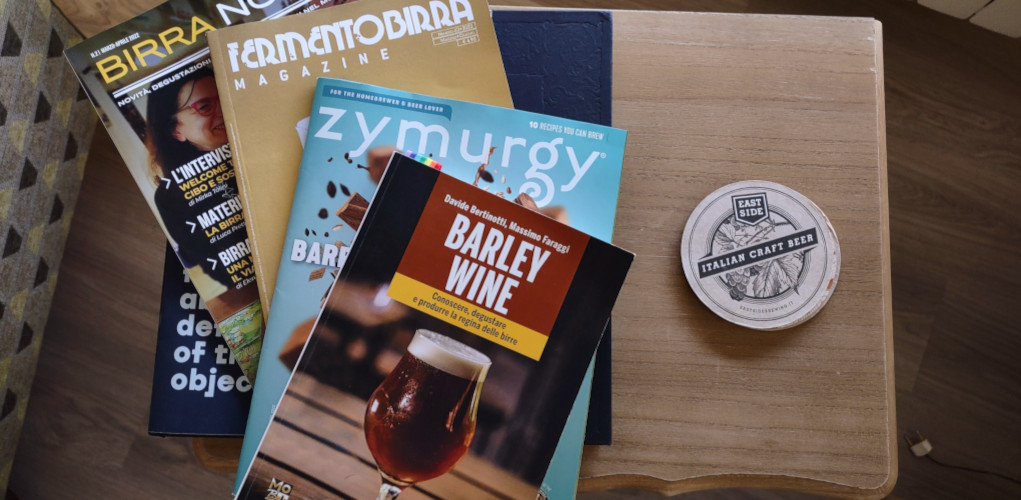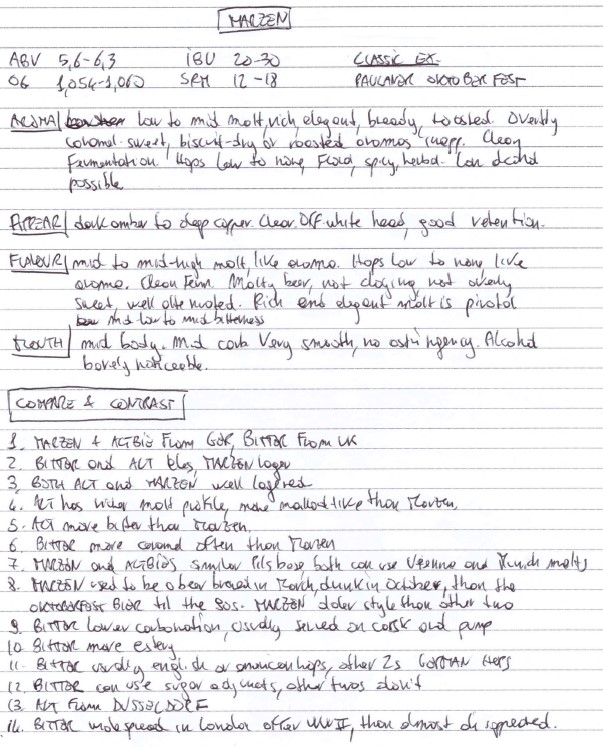I’ve previously posted a couple blog pieces about getting ready for my Written Exam (here). I wasn’t sure how well I did, so I didn’t go over every exam question in depth. Before offering advice on how to respond to the exam questions, I wanted to be sure that my strategy had worked. I scored 93 out of 100 on the Written Exam. It did work, then.
So, here we go.
I’ll start with the two mini-essays on beer characteristics (the triplet questions), which are quite hard to tackle. I put a great deal of planning into it, attempting to find the least painful approach to memorizing all the beer styles and putting them down in a clear and concise manner within the required time frame.
For a comprehensive summary of my complete Written Exam, please see my earlier post.
To learn more about the Written Exam structure, please read here.
To learn more about the T/F questions, please read here.
The styles question
There are two questions about styles. They have the same structure but involve different beer styles. You have to describe and compare three beer styles for each of the two questions. It is a sort of mini–essay on beer characteristics.
The description of each style should be complete but concise at the same time. You have to go through all the main characteristics of each style: appearance, aroma, flavour, mouthfeel. This part weighs 50% of the total question score.
You are required to compare and contrast the three styles. Your answer should go through differences in ingredients, serving methods, history, and nationality. This part weighs 40% of the overall question score.
At the time I took the exam, it was required to list ABV, OG, IBU, and SRM ranges for each style. Fortunately, this is no longer necessary (more on that here). You still have to write down a commercial example for each style, but these are far easier to remember than all of them fricking numbers. This simple list of three commercial examples contributes to 10% of the total score of the question.
How to prepare for this question
First, let’s look at the triplet pool, from which the questions are randomly selected. This list is available here. Remember that the list of triplets is subject to change, so make sure to check it before you begin.
There are 91 triplets. They cover 84 styles. Basically, the “classic” 2021 BJCP Guidelines styles, ranging from category 1 to 26. No historical beers, no wild fruit or sour, except the classic ones in category 23 (Lambic, Gueze, and the like). As of this writing, there are also six traditional styles that—don’t ask me why—do not show up in any of the 91 triplets:
- Czech Dark Lager
- White IPA
- Red IPA
- Brown IPA
- Black IPA
- Rye IPA
I will not consider these six styles relevant to the Written Exam.
Unless you are a memory freak, which I am not, it would be nearly impossible to remember all 84 style descriptions in depth in a reasonable amount of time. Therefore, I advise concentrating on a subset of styles initially.
Let’s start with the 12 styles that are also part of the pool for the recipe question, where you will be required to write a style description as well. These styles are listed on the BJCP website (here). I counted the number of triplets (in parenthesis) that have at least one of these styles:
- Märzen (11)
- Irish Stout (8)
- American Porter (7)
- German Pils (6)
- Weissbier (5)
- Doppelbock (4)
- Double IPA (4)
- Czech Premium Pale Lager (3)
- Belgian Tripel (3)
- American IPA (2)
- Strong Bitter (2)
- Festbier (1)
This is your Tier 1. Learn these 12 styles as a Master-level judge.
It is not easy to understand what describing the style as a Master-level judge exactly means. You can get a hint by reading my Written Exam (I am not a Master-level judge, but I got a Master score on those answers). You’ll see that the style descriptions are not identical copies of what is written in the BJCP Guidelines, but all the descriptors and their intensities are essentially correct.
Now, Tier 2. Focus on all the styles that appear at least in 4 triplets, excluding the first 7 entries of the previous list (because we already put them in Tier 1 – Master Level).
- Foreign Extra Stout (9)
- Wee Heavy (9)
- American Stout (8)
- Dunkles Bock (7)
- American Pale Ale (6)
- English Barleywine (6)
- International Amber Lager (6)
- Munich Helles (6)
- Lambic (6)
- Scottish Light (6)
- American Barleywine (5)
- Best Bitter (5)
- Scottish Heavy (5)
- Munich Dunkel (5)
- Sweet Stout (5)
- American Wheat Beer (4)
- California Common (4)
- Altbier (4)
- Helles Bock (4)
- Schwarzbier (4)
Learn these additional 20 styles as a National-level judge.
The remaining 52 styles falls into Tier 3 – Certified Level. You could also extend this approach to a Tier 4 – Recognized Level, but the risk of getting a score lower than 80 would be sensibly higher.
Focusing on the first two tiers will get you approximately a National average score on more than half of the triplets.
In my exam, I got 5 styles out of the total 6 from this 27 pool, on which I focused on: Marzen, Altbier, German Pils, Czech Premium Pale Lager, and Best Bitter.
I was indeed fortunate, but a probabilistic method may favor luck.
You can gradually introduce new styles into Tier 2, or scale up styles from Tier 2 to Tier 1. But start off by focusing on the first 32 styles of Tier 1 and Tier 2.
Give it some time. Proceed step-by-step. Avoid trying to do too much at once; it would be overwhelming.
How to memorize a lot of stuff
Memory is a tricky asset. There are numerous ways to memorize a lot of data. I am not an expert on that, but I can tell you what worked for me.
To reduce the learning curve, I suggest creating schematics. Put the Belgians and the stouts in groups and focus on the key distinctions and similarities between close styles. I created this infographic about stouts and this one about Belgian beers as references. They were really helpful to me in recalling the key elements of each style.
I also made a list of all the beers where hop aroma is optional, the ones with vinous nuances, and the ones with dried fruit. You can also make a list of the styles where diacetyl is allowed. You’ll learn that diacetyl is allowed in all dark ales with the exception of the Irish ones and the British Brown Ale, which is easy to remember.
A lot of people use flash cards to memorize beer styles. Personally, I don’t like them. I think they don’t add much to what can already be found in the BJCP official guidelines (which are quite schematic as well). I printed out the BJCP Guidelines and studied them on paper, highlighting important keywords and jotting down the main features of each style with a pencil. This is how my BJCP 2021 printed guidelines look now.

Last but not least: practice, practice, and practice again. Even writing down just one style each day would be useful. I made an Excel where you can select triplets randomly from the official pool (you can find it here).
The good thing about the styles question is that you have all the correct answers in the guidelines. So you can practice and check the answer immediately.
Repeated attempts with feedback are a solid method for learning stuff. More on that here.
How to write the answer
I eventually chose not to follow Al Boyce’s recommendation (here) to use tables for describing and comparing styles. When I first started practicing, I attempted to follow his advice, but I quickly discovered that I was just wasting time drawing all the tables.
It’s not that graders dislike the Al Boyce tabular approach, or that I don’t think it’s a good idea. Simply put, I find it very challenging to convey a thorough understanding of beer styles when utilizing tables.
On the other hand, I didn’t like the idea of writing a lengthy text essay because it would be difficult to write, read, and grade. As a result, I chose to stick with a schematic strategy but at the same time I avoided drawing any tables.
I prepared to write down this answer in 18 minutes, using 3 sheets of paper. Since answering some styles questions may take up to 20 minutes, set yourself to answer both of them in 38 minutes. You will have 2 minutes spare to manage a longer-than-usual answer.
Here is an extract from my exam with the Marzen style description and the comparison with an Altbier and a Best Bitter.
Let’s start practicing, then!
That being said, it all depends on your expectations. My strategy was to get the most from the Written Exam in order to avoid having to take it again in the future. I already had a solid tecnical background which made all the stydying a little less tiresome.
But if you just want to get to the National level without too much hassle, the learning curve may be somewhat lowered.
My recommendation is to commit a few months to it in any case, using a methodical approach to prevent everything from getting too much to handle at once.
It’s all up to you!
For your reference, I’ve included the Excel spreadsheet I used to tally all the styles in the triplets and the likelihood of receiving a particular score depending on how well-versed in each style you are. Although it is not an Excel that is easy to use, it might be helpful as a basis for developing a study plan.





